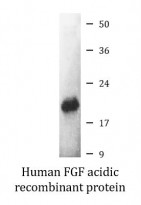ARG70108
Human FGF acidic recombinant protein (Active) (His-tagged, C-ter)
Human FGF acidic recombinant protein (Active) (His-tagged, C-ter) for SDS-PAGE
Overview
| Product Description | E. coli expressed, His-tagged (C-ter) Active Human FGF acidic recombinant protein |
|---|---|
| Tested Application | SDS-PAGE |
| Target Name | FGF acidic |
| Species | Human |
| A.A. Sequence | Phe16 - Asp155 |
| Expression System | E. coli |
| Activity | Active |
| Activity Note | Determined by its ability to induce 3T3 cells proliferation. The ED50 for this effect is < 0.3 ng/mL. The specific activity of recombinant human FGF-1 is > 1 x 10^6 IU/mg. |
| Alternate Names | HBGF1; FGF-1; FGF-alpha; GLIO703; ECGFA; ECGFB; ECGF; Endothelial cell growth factor; FGFA; Acidic fibroblast growth factor; Heparin-binding growth factor 1; Fibroblast growth factor 1; HBGF-1; AFGF; aFGF; ECGF-beta |
Properties
| Form | Powder |
|---|---|
| Purification Note | Endotoxin level is less than 0.1 EU/µg of the protein, as determined by the LAL test. |
| Purity | > 98% (by SDS-PAGE) |
| Buffer | PBS (pH 8.0) |
| Reconstitution | It is recommended to reconstitute the lyophilized protein in sterile water to a concentration not less than 200 μg/mL and incubate the stock solution for at least 20 min at room temperature to make sure the protein is dissolved completely. |
| Storage Instruction | For long term, lyophilized protein should be stored at -20°C or -80°C. After reconstitution, aliquot and store at -20°C or -80°C for up to one month. Storage in frost free freezers is not recommended. Avoid repeated freeze/thaw cycles. Suggest spin the vial prior to opening. |
| Note | For laboratory research only, not for drug, diagnostic or other use. |
Bioinformation
| Gene Symbol | FGF1 |
|---|---|
| Gene Full Name | fibroblast growth factor 1 (acidic) |
| Background | The protein encoded by this gene is a member of the fibroblast growth factor (FGF) family. FGF family members possess broad mitogenic and cell survival activities, and are involved in a variety of biological processes, including embryonic development, cell growth, morphogenesis, tissue repair, tumor growth and invasion. This protein functions as a modifier of endothelial cell migration and proliferation, as well as an angiogenic factor. It acts as a mitogen for a variety of mesoderm- and neuroectoderm-derived cells in vitro, thus is thought to be involved in organogenesis. Multiple alternatively spliced variants encoding different isoforms have been described. [provided by RefSeq, Jan 2009] |
| Function | Plays an important role in the regulation of cell survival, cell division, angiogenesis, cell differentiation and cell migration. Functions as potent mitogen in vitro. [UniProt] |
| Cellular Localization | Secreted. Cytoplasm. Cytoplasm, cell cortex. Cytoplasm, cytosol. Nucleus. Note=Lacks a cleavable signal sequence. Within the cytoplasm, it is transported to the cell membrane and then secreted by a non-classical pathway that requires Cu(2+) ions and S100A13. Secreted in a complex with SYT1. [UniProt] |
| PTM | In the nucleus, phosphorylated by PKC/PRKCD. [UniProt] |
Images (1) Click the Picture to Zoom In






